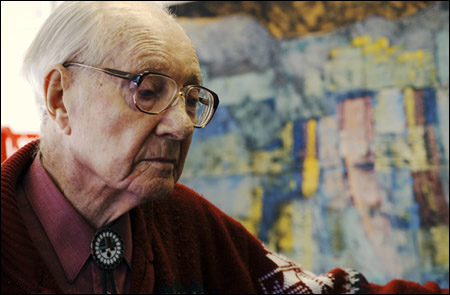Whipple, world-renowned astronomer, dies

Fred Lawrence Whipple, whose work on comets revolutionized our understanding of these once enigmatic visitors, died Aug. 30 at the age of 97 following a prolonged illness. He was the Phillips Professor of Astronomy Emeritus at Harvard and a senior physicist at the Smithsonian Astrophysical Observatory (SAO).
“Fred Whipple was one of those rare individuals who affected our lives in many ways,” said Charles Alcock, current director of the Harvard-Smithsonian Center for Astrophysics (CfA). “He predicted the coming age of satellites, he revolutionized the study of comets, and as director of the Smithsonian Astrophysical Observatory, he helped form the Harvard-Smithsonian Center for Astrophysics.”
George Field, the first CfA director, says of Whipple, “He will be remembered by a generation of scientists for his leadership and for his keen insight. He was admired by his friends and colleagues for his integrity, and for doggedly pursuing his research into his 90s.”
A discoverer of six comets, all of which bear his name, Whipple may be best known for his comet research. Five decades ago, he first suggested that comets were “icy conglomerates,” what the press called “dirty snowballs.” His dirty snowball theory caught the imagination of the public even as it revolutionized comet science.
A 2003 survey by The Astrophysical Journal showed that Whipple’s 1950 and 1951 scientific papers on the “icy conglomerate” model were the most cited papers in past 50 years. According to Brian Marsden, director of the Minor Planet Center located at SAO, Whipple’s theory was “one of the most important contributions to solar system studies in the 20th century.”
Whipple’s comet work continued for a lifetime. In 1999, he was named to work on NASA’s Contour mission, an attempt to observe two comets at close range, becoming the oldest researcher ever to accept such a post.
Whipple also contributed to more earthly challenges. During World War II, he co-invented chaff – fragments of aluminum foil that Allied aircraft would release to confuse enemy radar. Whipple was particularly proud of this invention, for which President Truman awarded him a Certificate of Merit in 1948.
Whipple also strongly influenced the early era of spaceflight. Mindful of the damage to spacecraft from meteors, in 1946 he invented the Meteor Bumper, a thin outer skin of metal also known as the Whipple Shield. The mechanism explodes meteors on contact, protecting spacecraft from catastrophic damage. Improved versions of it are still in use.
While Whipple and a handful of other scientists had the foresight to envision the era of artificial satellites, only Whipple had both the imagination and the managerial skill to organize a worldwide network of amateur astronomers to track these then hypothetical objects and to determine their orbits. When Sputnik I was successfully launched on Oct. 4, 1957, Whipple’s group was the only one prepared, and Cambridge soon became a nerve center of the space age. Whipple and some of his staff were even featured on the cover of Life magazine for their satellite tracking prowess.
Later, also under his leadership, SAO developed an optical tracking system for satellites. That network achieved spectacular success. “It tracked satellites so well that astronomers were able to determine the exact shape of the Earth from its gravitational effects on satellite orbits,” says Myron Lecar, lecturer on astronomy at SAO.
For his work on the network, Whipple received the Distinguished Federal Civilian Service award from President John F. Kennedy in 1963. “I think that was my most exciting moment, when I was able to invite my parents and my family to the Rose Garden for the award ceremony,” Whipple said in a 2001 interview.
Born in Red Oak, Iowa, on Nov. 5, 1906, Whipple studied at Occidental College and earned his undergraduate degree in mathematics at the University of California, Los Angeles, prior to moving to Berkeley to obtain his Ph.D. in 1931. He then moved to Harvard College Observatory in Cambridge, Mass.
Whipple directed the Smithsonian Astrophysical Observatory from 1955 to 1973, before it joined with the Harvard College Observatory to form the Harvard-Smithsonian Center for Astrophysics (CfA). In the late 1960s, Whipple selected Mount Hopkins in southern Arizona as the site for a new SAO astronomical facility. In 1981, it was renamed Fred Lawrence Whipple Observatory.
Whipple is survived by his wife, Babette; a son, Earle; and two daughters, Sandra and Laura.




